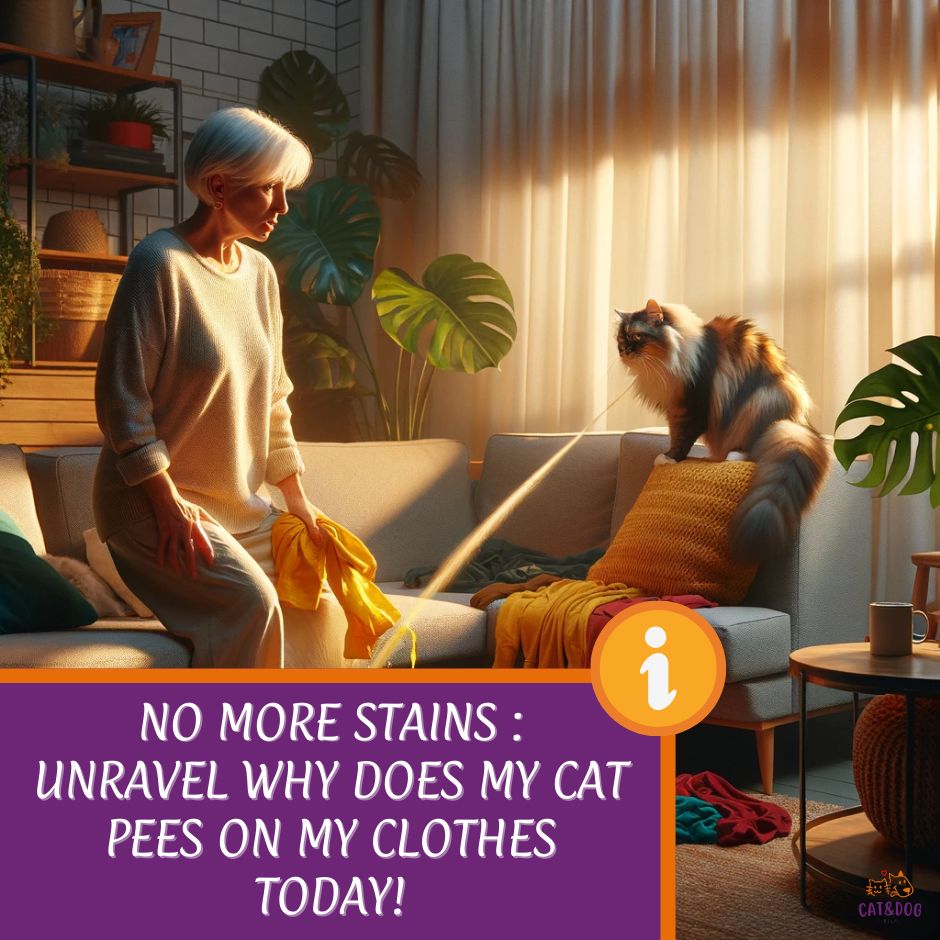Many cat owners are confronted with the confounding dilemma: “Why does my cat pee on my clothes?”
This behavior, as bewildering as it is exasperating, represents more than just an attack on your wardrobe; it marks a curious departure from your cat’s typically unblemished bathroom conduct.
In this blog, we’ll delve into the myriad reasons behind “Why does my cat pee on my clothes,” covering everything from potential medical issues and behavioral concerns to problems with the litter box, such as the type of litter used.
Together, we’ll navigate the complexities of this issue and uncover effective strategies to address your cat’s unseemly choice of bathroom spot.
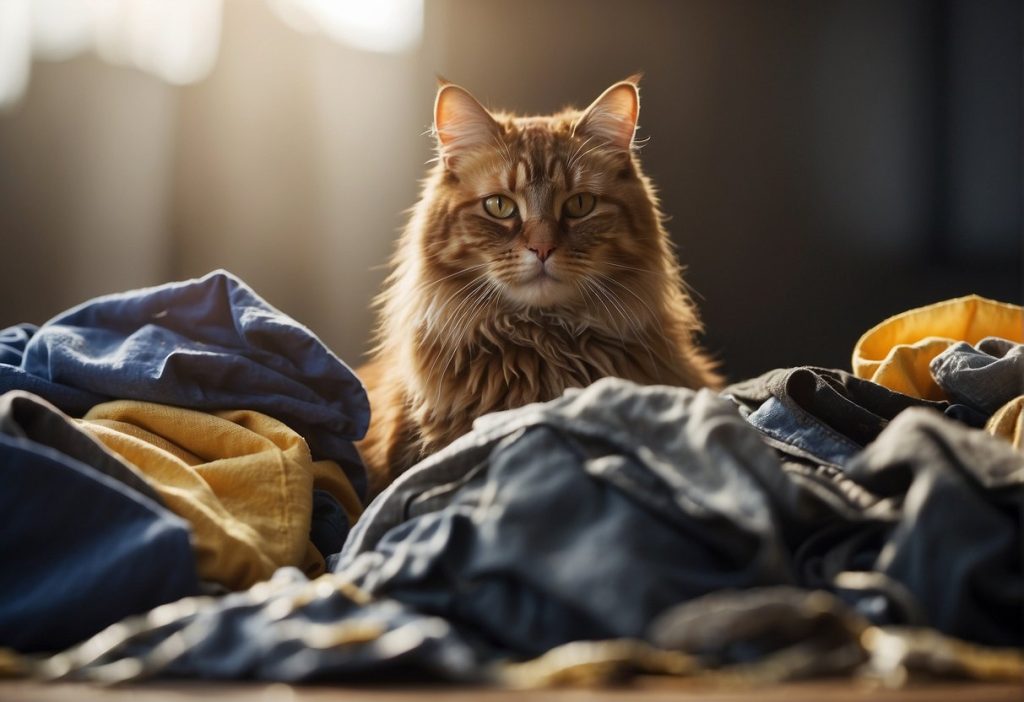
Addressing this issue is not just about saving your wardrobe—it’s crucial for the well-being of your cat. Understanding why cats engage in this behavior is the first step to stopping it.
The reasons can be complex, ranging from medical problems to stress-related behaviors.
Addressing the root cause often requires a combination of veterinary insight and adjustments to your cat’s environment or routine.
Recognizing early signs of distress or discomfort in your cat can be key in nipping this problem in the bud and maintaining a happy home for both you and your pet. (1)
Cats communicate much through their behavior, and unexpected changes, like peeing on clothes, can signal that something isn’t quite right.
It’s imperative to approach the issue with empathy and a willingness to explore different solutions—whether that means a cleaner litter box, more playtime, or a visit to the vet.
With a careful and informed approach, cat owners can usually find the best way, or as some may say, the cat’s way, to restore order and cleanliness to their homes through positive reinforcement training, which is the only way to effectively communicate with cats.
Incorporating enrichment and positive reinforcement training, such as giving rewards or praise, can also help teach cats the best way to urinate in appropriate locations.
Key Takeaways
- Unraveling the reasons behind a cat’s inappropriate urination is essential for both the pet’s and the owner’s happiness.
- Medical issues or stress can cause cats to pee on clothes; observing your cat’s overall behavior helps identify the root cause.
- Effective solutions often involve a combination of environmental changes, emotional support, and, if necessary, professional advice.
Understanding Why Does My Cat Pees on My Clothes
Remember, your cat isn’t just a pet, but a member of your family with its unique way of sending messages.
It’s like living with a tiny, furry roommate who has their own set of house rules, including avoiding certain areas or objects such as rugs and laundry.
Understanding your cat’s behavior, including their aversion to certain scents like vinegar and baking soda, is key to addressing any unwanted behaviors like peeing on soda-scented laundry.
In some cases, this behavior may be a sign of a urinary tract infection, which can be easily treated with antibiotics.
Introduction to Feline Behavior
Cats, by nature, are quite sophisticated creatures when it comes to non-verbal communication. It might just be their way of telling you something’s up.
They might feel stressed, or unwell, or maybe there’s something about that litter box they’re just not digging.
If you’ve been spending a lot of time in their designated space or there’s a new pet in the house, your cat may feel threatened and mark their territory by peeing on your clothes to seek attention and affection.
Understanding your cat’s behavior and the underlying cause of their stress or anxiety, such as changes in their environment or routine, can help prevent this issue.
Creating a stable and comfortable environment for your cat, especially during times of change like moving to a new home, can also help alleviate any underlying causes of stress or anxiety.
Signs of Distress in Cats
Here’s a quick checklist to help you decide what your little whiskered pal might be feeling:
- Spraying or urinating outside the litter box
- Increased vocalization (more meows or those heart-wrenching yowls)
- Changes in eating or sleeping habits
- Excessive grooming or, conversely, a lack of grooming
So, what do these behaviors suggest? Maybe your cat’s stressed out about the new couch, or perhaps a health hiccup is making them avoid the litter box.
Cats are pretty sensitive to their environments, so even a small change can set off a chain reaction.
Thankfully, a bit of observation and some sleuthing can go a long way in understanding your cat’s behavior and getting to the bottom of those “accidents” on your clothes, bedding, and other belongings.
Using vinegar as a deterrent can also help prevent your cat from marking their territory on your belongings.
However, if the behavior persists, it may be a sign of a larger issue and it is important to consult with a veterinarian for proper diagnosis and treatment.
Medical and Behavioral Causes
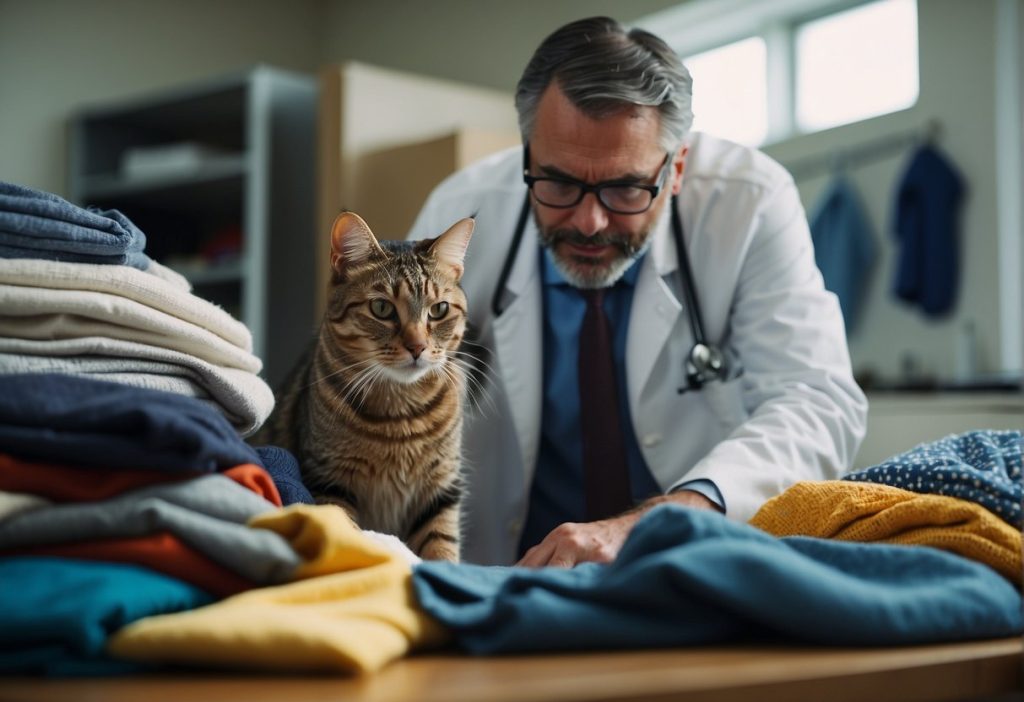
Let’s unravel this mystery together, digging into both medical and behavioral reasons behind this peculiar cat behavior.
Medically speaking, it could be a urinary tract infection (UTI) raising havoc, or other kidney problems such as crystals in the urine or bladder stones, which are more common in male cats. (2)
UTIs and kidney issues are no joke for cats, as they come with symptoms like frequent trips to the bathroom, a painful condition during urination, and sometimes even blood in their urine caused by inflammation.
This painful condition, known as painful urination, can cause cats to associate their litter box with discomfort, leading them to urinate in other places.
I see those ears perking up at the mention of vet visits—yes, these medical concerns require your vet’s help, pronto!
Understanding the potential medical causes, such as UTIs and kidney problems, and behavioral causes, such as stress, of your cat’s peeing behavior is crucial in addressing the issue.
Next up: chronic kidney disease (CKD). If your kitty’s water bowl empties quicker than a leaky faucet and the litter box is always… well, ‘in use’, it might be CKD. (3)
A vet’s insight is crucial here, and they might chat about diet tweaks and meds to manage your cat’s condition.
Now, let’s shift gears to behavioral aspects:
- Territorial Marking:
Cats, both male and female, have a VIP pass to the marking club, especially if they haven’t been neutered or spayed.
Neutering can significantly reduce the odds of your cat mistaking your wardrobe for their turf! (4) - Stress and Anxiety:
Unwanted urination can signal your cat is stressed—think of it as a feline’s SOS flag. New pets, a move, or even a change in your home’s vibe can trigger such responses.
Just like us after a long day, your cat’s looking for comfort! (5)
Understanding these causes is your first step in deciphering your cat’s cryptic messages. Remember, no issue is unsolvable with a little patience and a lot of love!
Enhancing Solutions with Missing Elements
Cats peeing on clothes is frustrating, but fret not! Your journey to a pee-free wardrobe starts with behavioral tweaks and a sprinkle of patience.
Has your kitty got the blues? Cats are creatures of habit, and even slight changes might throw them off.
Let’s turn Sherlock and eliminate the ‘pee-tential’ stressors. Create a stable haven with predictable meal times, play sessions, and cuddle sessions.
For the love of clean laundry, let’s amp up the litter box allure:
- Squeaky Clean Routine:
No one likes a dirty bathroom, and your feline is no exception.
- Daily: Scoop it!
- Weekly: Wash it!
- Daily: Scoop it!
- Location, Location, Location:
Ensure the box is in a quiet, accessible spot—not next to their food or in a high-traffic area. - The Right Fit:
Make sure it’s spacious enough for your cat to turn and dig.
Positive vibes only, right? Try pheromone diffusers for a calming environment, or soothe with supplements. Now, here’s the game-changer: Clicker training! It’s not just for dogs.
Here’s how you can become a clicker wizard to encourage litter use:
- Click: right when they sniff or scratch in the box.
- Treat: immediately after the click to create a positive association.
- Repeat: Clicker fun time should be short and sweet!
Owners like you have seen a whopping success rate with these strategies. From anecdotal cheers to published case studies, the proof is in the purring.
Remember, your cat’s behavior is like a puzzle, but together we can solve the mystery of the misplaced pee!
Building Trust and Authority
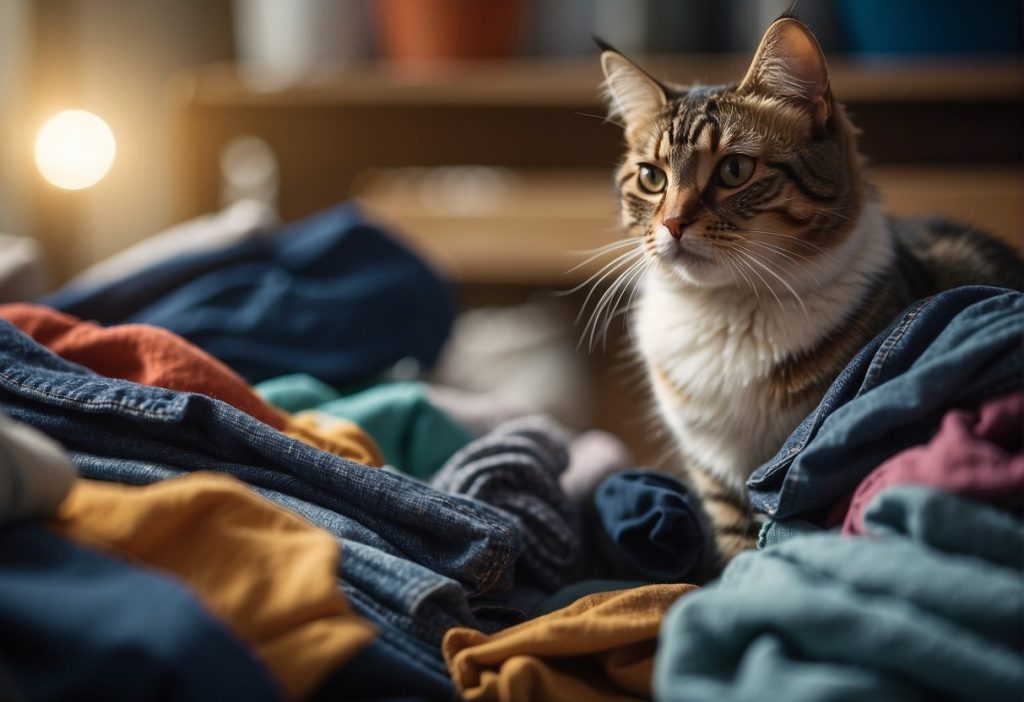
Veterinary Insights on Feline Lower Urinary Tract Diseases (FLUTD):
FLUTD encompasses a range of conditions that can affect your cat’s urinary health. These issues may trigger unusual behaviors, such as choosing your wardrobe for a pee spot.
- Diagnosis: Vets perform urine tests and ultrasounds to diagnose FLUTD. (6)
- Treatment: Options include anti-inflammatory medications and dietary changes.
- Recovery Rates: With proper treatment, many cats recover, but some may have recurrent episodes.
The Diet Impact:
Believe it or not, what your cat eats can play a role in urinary health.
- Dry Food: This predisposes some cats to urinary issues due to lower moisture content.
- Wet Food: Can help maintain hydration and reduce the risk of urinary problems.
Community Insights: A Cat Owner’s Tale of Triumph:
Meet Sarah, whose Persian cat, Mr. Whiskers, turned her laundry pile into his litter box.
After discovering Mr. Whiskers had FLUTD, a combination of medical treatment and behavioral modification was the game-changer.
- Medical Treatment: Mr. Whiskers was prescribed medication and switched to prescription wet food.
- Behavior Modification: Sarah also provided a stress-free environment and clean litter boxes.
These changes didn’t just improve Mr. Whiskers’ health; they restored harmony to Sarah’s home. No more unwanted surprises on her clothes!
Remember, each cat is unique, so what worked for Mr. Whiskers might not be a one-size-fits-all solution.
However, understanding the underlying issues and working closely with your vet can put you on the path to solving the pee puzzle.
Preventive Measures and Solutions

Here’s a neat trick: one litter box per cat, plus one extra. And friends, cleanliness is next to cattiness.
Studies show that cats prefer a sparkling clean spot to do their business, keeping those clothes piles pristine.
So, be diligent and scoop daily! Additionally, it’s important to experiment with different types of cat litter, including litter type, as some cats may have preferences.
Litter box optimization, including the number of boxes and their type and placement, can also help prevent accidents and ensure your cat’s comfort.
Now, what about the jitters and jangles of kitty life? A chill cat is a happy cat, and a happy cat doesn’t need your sweater as a bathroom.
Create a snug-as-a-bug environment with hiding spots, consistent routines, and playtime. About toys – laser pointers and puzzle feeders aren’t just fun, they’re sanity-savers!
Speaking of feeding, let’s chew on some nutritional nuggets. If urinary issues crop up, a quick vet visit is your first play.
They might suggest a diet switcheroo to something that supports urinary tract health – think more moisture, less stress on those kitty kidneys.
Remember, a spoonful of prevention is worth a wardrobe of clean clothes. Implement these steps:
- Litter Mastery:
- Boxes: 1/cat + 1 extra
- Cleaning: Daily scooping and regular washing
- Boxes: 1/cat + 1 extra
- Stress Busters:
- Routine: Feed and play on schedule
- Toys: Offer a variety to keep them engaged
- Routine: Feed and play on schedule
- Health Tweaks:
- Vet Check-ups: Regular wellness visits
- Diet: Ask about special urinary health formulations
- Vet Check-ups: Regular wellness visits
Stay on top of litter, sprinkle in some fun, and keep the menu fresh. Your kitty’s health and your laundry will thank you!
Quick Recap
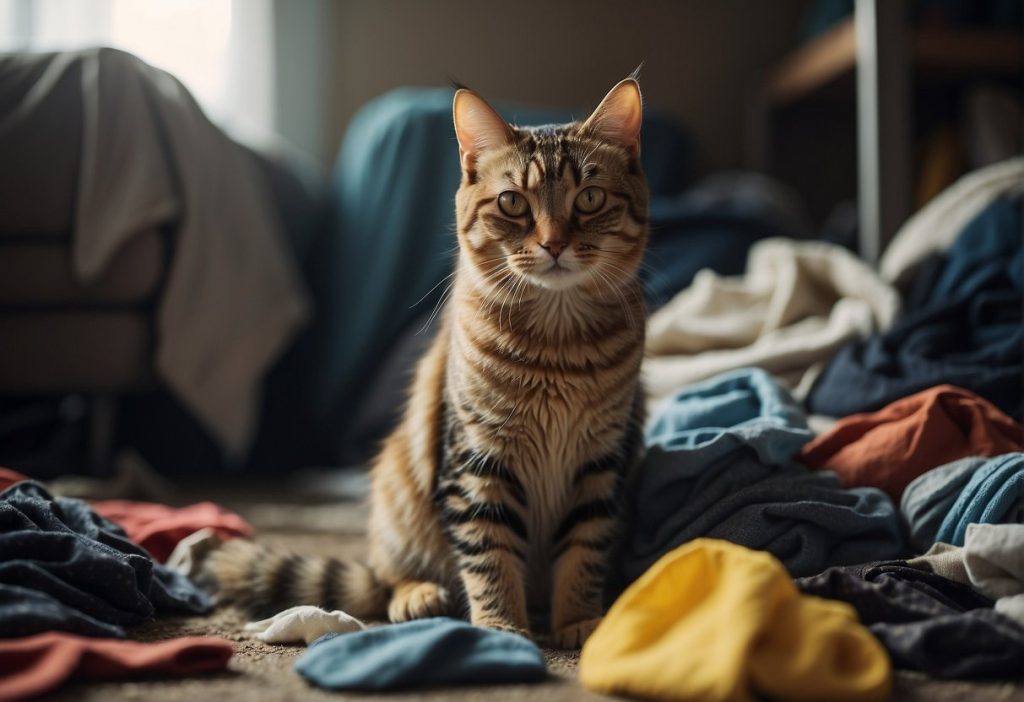
Let’s quickly skim through the main takeaways on why your cat might be using your clothes as a litter box substitute.
- Cleanliness is Key:
Your cat craves a pristine spot to do their business. A dirty litter box could be the culprit behind them turning to your clothes. - Signs of Stress:
Like us, cats can get anxious. Stress might be leading them to leave their mark on your garments. - Territorial Tendencies:
Especially in multi-cat households, your kitty might be laying claim to your closet through their scent. - Health Matters:
Conditions like urinary tract infections (UTIs) or kidney issues could lead to uncomfortable associations with the litter box.
When you’re dealing with a cat that thinks your clothes are their toilet, remember, patience is a virtue. Don’t scold; empathize.
Here’s what you could do:
- Regularly clean the litter box.
- Create a stress-free sanctuary for your whiskered companion.
- Check for any health concerns with a vet.
It’s not just about the mess; it’s about understanding your four-legged family member. Have you tackled a similar issue? Share your experience in the comments!
If you’re still scratching your head, consider reaching out to a vet. Remember, you’re not alone in this—many pet parents have navigated these waters.
Next step? Take action and reinforce that bond with your furry pal.
Frequently Asked Questions
Discovering why your favorite feline friend decides to turn your wardrobe into its lavatory can be both puzzling and exasperating.
Here’s the scoop on the most pressing queries cat owners have when they face this smelly dilemma.
Why does my cat pee on my clothes but not on other family members’ clothes?
It’s possible your cat feels a stronger attachment to you, or perhaps your clothes have a more appealing scent.
Cats often target items with a familiar smell when they feel stressed or seek comfort.
Can changing my cat’s diet stop it from peeing on clothes?
While diet isn’t typically a direct cause of urinating on clothes, ensuring your cat has balanced nutrition can aid overall health and reduce stress, possibly impacting such behaviors indirectly.
How do I clean cat urine effectively to prevent re-marking?
Use an enzyme-based cleaner specifically designed for pet odors to break down the urine.
Avoid ammonia-based products, as they can mimic the smell of urine and might encourage your cat to re-mark the spot.
Is it a behavioral issue if my cat only pees on my bed?
If your cat chooses your bed for peeing, it might be a sign of a behavioral issue such as separation anxiety, especially if it happens when you’re away.
Creating a comforting environment could help.
How often should I clean the litter box to prevent my cat from peeing on clothes?
Ideally, scoop the litter box daily and clean it thoroughly once a week. A clean litter box is less likely to deter your cat from using it.
Will getting another cat help if my cat pees on clothes due to loneliness?
Introducing a new cat might help with loneliness, but it could also lead to territorial issues.
It’s crucial to consider your current cat’s temperament and introduce any new pets slowly and carefully.
Can anxiety in cats lead to peeing on clothes, and how can I reduce it?
Yes, anxiety can result in such behaviors.
Reduce anxiety by maintaining a stable routine, providing interactive playtime, and considering pheromone diffusers, which can have a calming effect.

